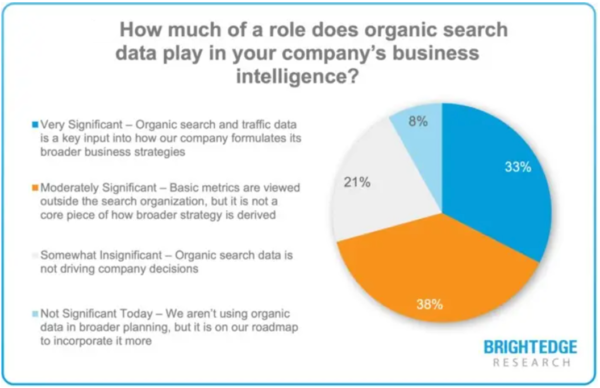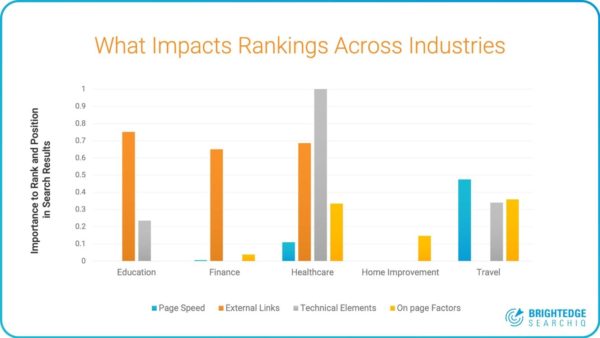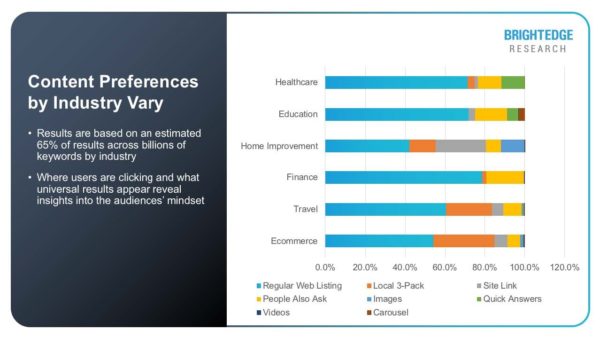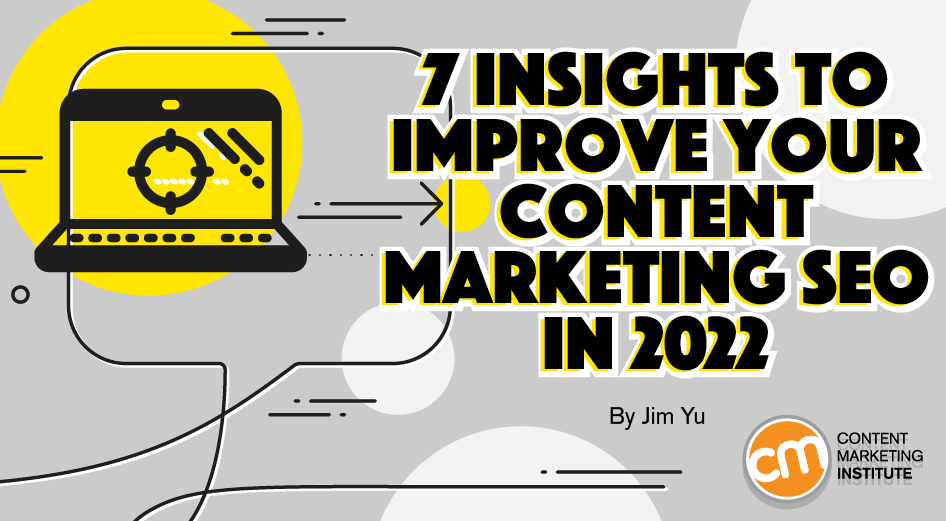Given the evolution of consumer behavior and the sheer volume of content being produced, content marketers cannot solely rely on historic SEO performance data as indicators of future success.
Google’s mission hasn’t changed – it simply wants to provide the best answer for each query. However, its ability to provide that best answer has evolved so it can deliver the best option more frequently.
Given 71% of marketers says organic search play a role in their business intelligence, it’s important to learn as much as you can about how search connects to your business, target audience, and more. Here are seven areas to explore.

1. Market insights
In HubSpot’s Not Another State of Marketing Report 2021, 83% of marketers say they conduct market research, and 88% of that group use that research to inform business decisions. Of those surveyed, 67% of marketers plan on increasing market research spending in the next year.
Understanding your market in detail can help you better identify the ranking and traffic potential of content assets. Keyword research is essential granular activity here as it helps determine the terms and phrases used by customers to find content, products, and services like yours.
Understanding your market in detail can help better identify the ranking and traffic potential of your content assets, says @JimYu via @CMIContent. #SEO Click To TweetYou also need to know the sites appearing at the top of the results for those search terms. It may not be a traditional business competitor. For example, the top content might come from a major media publication, educational institution, or government agency creating relevant content on your topic.
Rank tracking and analyzing market insights can help you spot macro market trends and category level opportunities to optimize content for more specific intents, longer tail keywords, and less competitive SERPs.
2. Searcher intent
Knowing why your target audience searches allows you to deliver content that they will want to consume.
Knowing why your target audience searches allows you to deliver #content that they will want to consume, says @JimYu via @CMIContent. #SEO Click To TweetMap your existing content to your customers’ journey. See the gaps in your coverage. Maybe you’re doing a great job producing top-of-funnel awareness and informational content but don’t have content that answers commercial or transactional intent queries. (Or maybe that resource exists but isn’t ranking well and could use another round of optimization.)
You also can evaluate queries people use to find your content. When you have a good grasp of the why behind the queries you’re targeting, you can ensure that content continues to provide the best and most comprehensive answer.
Finally, you can go deeper to look at the micro-moments – the person’s mindset at the point of search. In 2015, Google released a series of white papers around four critical micro-moments of search behavior – know, go, do, and buy.
 Fast forward to 2021, micro-moment strategies are still hyper-relevant. Analyzing SERP results through a micro-moment lens can help you better align content to customer journeys and your content marketing strategy by:
Fast forward to 2021, micro-moment strategies are still hyper-relevant. Analyzing SERP results through a micro-moment lens can help you better align content to customer journeys and your content marketing strategy by:
- Understanding how videos, images, and quick-read content should be used
- Knowing how the target audiences and keywords differ in each micro-moment
- Improving alignment of keywords to their customer journey more quickly
- Identifying ways paid content strategies can complement SEO for multiple micro-moments to dominate targeted keywords and categories
- Helping you prioritize content spending closer to conversions.
3. Search types
How does your target audience search for the content? This can make a huge difference in the format and even the information to include.
How your target audience searches for #content can make a difference in how you format your content, says @JimYu via @CMIContent. #SEO Click To TweetIf you find 85% of your blog traffic finds your content through a mobile device, for example, you should seriously prioritize providing a quality mobile page experience. The impact of rank-contributing factors like page speed, external links, technical elements, and on-page factors vary by industry:

For example, if you operate in the finance sector, external linking matters most to content’s rank and position in search results. In travel, page load speed is a vital content ranking factor.
4. SERP positioning
Search engine result pages do not look exactly the same for every search. In addition to the traditional results with the title, search snippet, and link, they can now include dozens of features, including rich snippets, video and image results, map packs, people-also-ask questions and answers, etc.
It’s essential that you understand the types of results appearing on the SERP for the queries you’re targeting. For example, if the results page includes a listicle-style featured snippet that contains older, less authoritative content, it could be an excellent opportunity for your brand to create and optimize a better listicle article targeting the topic. Or, if you pursue a topic where a video appears on the SERP, you could create and optimize a video to win placement in those rich results appearing in that valuable real estate above the fold.
In many cases, you can learn from trends in your industry, as I show below, for health care, education, home improvement, finance, travel, and ecommerce. For example, health care and education see a segment of searchers who appreciate quick answers, but that type of content doesn’t even show up as a preference for home improvement, finance, or ecommerce.

5. Content types
SEO insights can also help decide which content types and platforms make the most sense for targeted keywords and audiences.
For example, a searcher who would click for an in-depth B2B buyer’s guide might expect an e-book over a blog post. While a searcher who wants a general overview likely would expect a high-level blog post on the topic, not a gated download.
You also may discover the original content type isn’t a good fit to attract searchers. For example, your market and keyword research tells you that the guide published last month should be performing a lot better than it is. Your search results, though, indicate it isn’t delivering as expected. To broaden its appeal, you repackage it into different types of content assets – a YouTube video, a SlideShare presentation, or a series of blog articles.
Use your on-site analytics and industry trend reports to inform which content types resonate and perform best for answering different user needs. Use these SEO insights to inform new content and make sure each existing piece is performing to its full potential.
Use #SEO insights to inform new #content and make sure each existing piece is performing to its full potential, says @JimYu via @CMIContent. Click To Tweet6. Real-time user behavior and automation
This advice gets a bit trickier as you can’t necessarily optimize content in response to what people are doing on your site in real-time. Yet, research from Segment, Accenture, and others indicates consumers get frustrated when content feels impersonal and most are more likely to shop with brands that give them personalized offers and recommendations.
AI-enabled SEO technology can be a huge assist to do this at scale. After all, by the time you review the site analytics and discover precisely what that visitor was looking for, they’re long gone.
We worked with Campbell’s where recipe content is a key driver in product awareness and sales. Using our company’s tool, their site automatically generated relevant internal links in the footer, labeling them as “members also viewed …” across all recipe pages. Within a few weeks, Campbell’s content moved to page one for 4,000 keywords.
7. Engagement and conversion insights
It’s important to know which key performance indicators (KPIs) will tell you whether a piece of content is doing its job. For example, ranking reports and site traffic are great, but are visitors interacting with your content or merely passing by?
Set up conversion tracking in Google Analytics to keep an eye on whether visitors are completing your targeted goal.
You also can look to your social media platforms to understand which content garners the most engagement. Can you replicate that success in search by targeting a different intent or topic area?
Bringing it all together
SEO is an ongoing process; there is no end to good results. Your SEO content strategy must stay on top of shifting consumer behavior, from targeted keywords to mobile optimization and from searcher intent to content types.
Are you making the best possible use of the SEO opportunity? As you plan for 2022, prepare to go deeper, too. Look for areas to streamline content optimization, get more granular in your personalization, and scale your efforts with smart automation.
Cover image by Joseph Kalinowski/Content Marketing Institute

